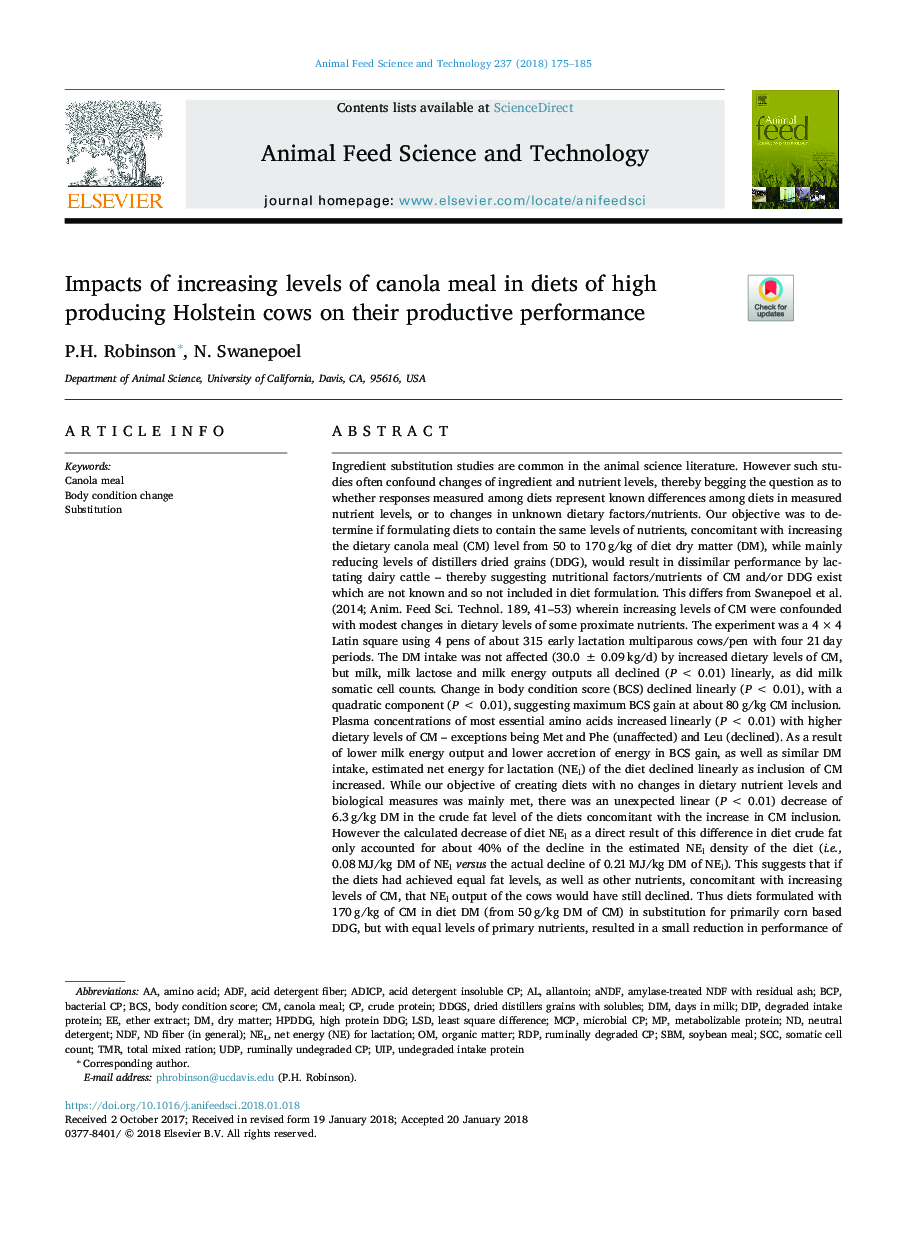| Article ID | Journal | Published Year | Pages | File Type |
|---|---|---|---|---|
| 8491019 | Animal Feed Science and Technology | 2018 | 11 Pages |
Abstract
Ingredient substitution studies are common in the animal science literature. However such studies often confound changes of ingredient and nutrient levels, thereby begging the question as to whether responses measured among diets represent known differences among diets in measured nutrient levels, or to changes in unknown dietary factors/nutrients. Our objective was to determine if formulating diets to contain the same levels of nutrients, concomitant with increasing the dietary canola meal (CM) level from 50 to 170â¯g/kg of diet dry matter (DM), while mainly reducing levels of distillers dried grains (DDG), would result in dissimilar performance by lactating dairy cattle - thereby suggesting nutritional factors/nutrients of CM and/or DDG exist which are not known and so not included in diet formulation. This differs from Swanepoel et al. (2014; Anim. Feed Sci. Technol. 189, 41-53) wherein increasing levels of CM were confounded with modest changes in dietary levels of some proximate nutrients. The experiment was a 4â¯Ãâ¯4 Latin square using 4 pens of about 315 early lactation multiparous cows/pen with four 21â¯day periods. The DM intake was not affected (30.0â¯Â±â¯0.09â¯kg/d) by increased dietary levels of CM, but milk, milk lactose and milk energy outputs all declined (Pâ¯<â¯0.01) linearly, as did milk somatic cell counts. Change in body condition score (BCS) declined linearly (Pâ¯<â¯0.01), with a quadratic component (Pâ¯<â¯0.01), suggesting maximum BCS gain at about 80â¯g/kg CM inclusion. Plasma concentrations of most essential amino acids increased linearly (Pâ¯<â¯0.01) with higher dietary levels of CM - exceptions being Met and Phe (unaffected) and Leu (declined). As a result of lower milk energy output and lower accretion of energy in BCS gain, as well as similar DM intake, estimated net energy for lactation (NEl) of the diet declined linearly as inclusion of CM increased. While our objective of creating diets with no changes in dietary nutrient levels and biological measures was mainly met, there was an unexpected linear (Pâ¯<â¯0.01) decrease of 6.3â¯g/kg DM in the crude fat level of the diets concomitant with the increase in CM inclusion. However the calculated decrease of diet NEl as a direct result of this difference in diet crude fat only accounted for about 40% of the decline in the estimated NEl density of the diet (i.e., 0.08â¯MJ/kg DM of NElversus the actual decline of 0.21â¯MJ/kg DM of NEl). This suggests that if the diets had achieved equal fat levels, as well as other nutrients, concomitant with increasing levels of CM, that NEl output of the cows would have still declined. Thus diets formulated with 170â¯g/kg of CM in diet DM (from 50â¯g/kg DM of CM) in substitution for primarily corn based DDG, but with equal levels of primary nutrients, resulted in a small reduction in performance of lactating dairy cows for reasons which are unknown, but may relate to lower conversion of digestible to metabolizable energy of the soluble carbohydrate fraction of CM versus DDG.
Keywords
BCPDIPacid detergent insoluble CPmicrobial CPDDGSUIPUDPTMRSBMRDPLSDSCCMCPaNDFNDFADFADICPAllantoinamino acidDIMacid detergent fiberSomatic cell countSubstitutionDried distillers grains with solublesNELdays in milkBCsether extractCanola mealorganic matterdry matterneutral detergentBody condition scorecrude proteinmetabolizable proteindegraded intake proteintotal mixed rationundegraded intake proteinSoybean meal
Related Topics
Life Sciences
Agricultural and Biological Sciences
Animal Science and Zoology
Authors
P.H. Robinson, N. Swanepoel,
